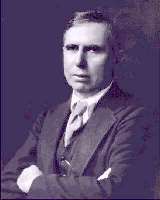
Born: August 27, 1871, in Terre Haute, Indiana, United States
Died: December 28, 1945, in Hollywood, California, United States
Theodore Dreiser was an American novelist, short- story writer, journalist, dramatist, poet, essayist, and autobiographer. As a naturalist, his writings depict the human condition as realistically as possible. His work is considered wholly American, free of the English influence.
Dreiser was one of ten children born to German immigrants whose Catholic outlook on life was shaped by a pessimistic-spiritual conviction and material adversity. Because his father was frequently unemployed, the family was poor and often had to look for work in different cities.
In 1887, Dreiser left home to attend Indiana University, Bloomington. However, the city fascinated him in a way that his classes could not. He obtained a position with a newspaper which assigned him to cover the city beat in Chicago and then St. Louis.
The primary influences on Dreiser's work include Honore de Balzac's work and Herbert Spencer's post- Darwinian philosophy. His friendship with Dr. A.A. Brill, an American Freudian, was no doubt also important as Dreiser's books often dealt with the psychological attributes of characters. Dreiser was additionally helped by his brother, Paul, a successful Broadway celebrity and songwriter.
The cold reality of his books did not sit well with the public. His first novel, Sister Carrie, was withdrawn by the publisher because of its depiction of sexual problems. This novel, however, set the stage for his later works, which often dealt with the harsh reality of life and the contrast between dreams and realities, the rich and poor. Dreiser often had to sell his stories in periodical form, which meant less money.
Dreiser was encouraged by the support of established writers such as H.G. Wells and Hugh Seymour Walpole after the publication of his second novel, Jenny Gerhardt. Most of his works inspired the same public outcry and controversy as his first novel, which provided popularity among the younger generation. Widely-acclaimed success came with the 1925 publication of An American Tragedy. This story, based on facts gathered about a real-life murder, has since been made into a motion picture.
One year before his death in 1945, Dreiser married Helen Richardson, with whom he had been living with since 1919. Ironically, marriage in his works often represents an end to the artistic individual.